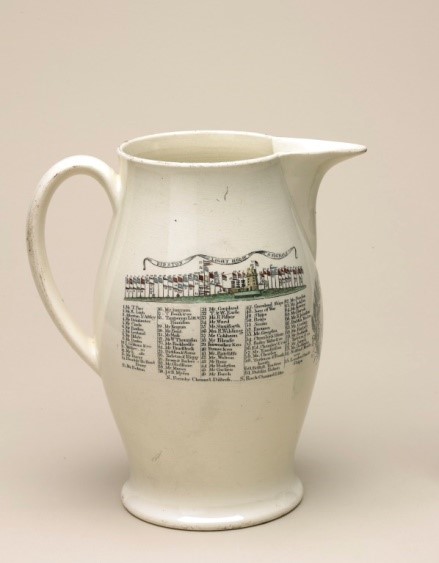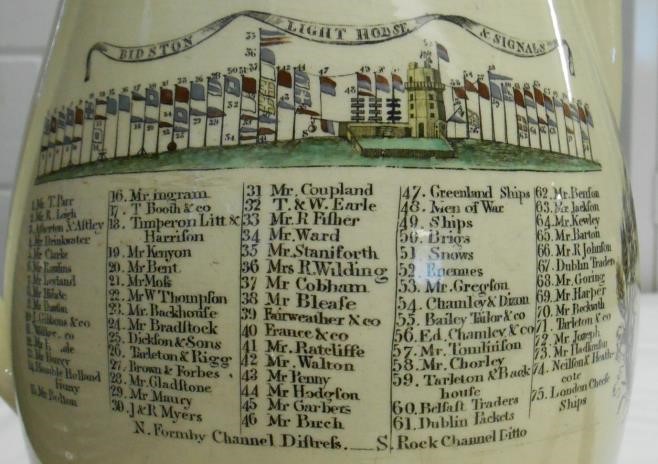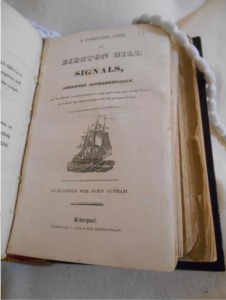Nicola Scott, Assistant Curator Decorative Art at National Museums Liverpool, discovers a fascinating aspect of Liverpool’s maritime history in the Special Collections Library.
I recently chose a jug in our decorative art collections to put on display at the Walker Art Gallery. One side of the jug features a view of the Bidston Lighthouse and Signals, with a key showing the different flags of the signalling system in colour. This subject was a popular design on cream-coloured earthenware in late 18th century England and its representation on ceramics has been a source of interest to writers ever since.

©National Museums Liverpool, Walker Art Gallery
The Bidston Lighthouse and Signals
I decided to do some research on the jug and aim to publish this. I wanted to establish when and where the jug was made. I thought that identifying the print on the jug would help and began by finding out more about the Bidston Signals themselves.
The Bidston Signals was a fairly simple system designed to give advance warning to merchants that their ship was in Liverpool Bay. Vessels were allocated a flag, which was hoisted from a particular flagpole when the ship was seen in the bay. The ship owners were able to see the signals on Bidston Hill from the town of Liverpool. This became a famous tourist attraction and people came to marvel at this well-known landmark.
I discovered that over the years the number of flags and ship owners represented grew from 14 in 1778 to 195 in 1820. The version on the jug lists 75 ship owners, shown here:

©National Museums Liverpool, Walker Art Gallery
 I thought that if I could identify the date of the print on the jug, this would give a clue as to the date of manufacture. My search took me to the wonderful Special Collections Library, a valuable resource for original archival research.
I thought that if I could identify the date of the print on the jug, this would give a clue as to the date of manufacture. My search took me to the wonderful Special Collections Library, a valuable resource for original archival research.
A rare book containing 19th century pamphlets [SPEC G35.19(11)] proved to be an important piece of evidence showing the Bidston Signals in 1820. It was a real privilege to be able to view this, particularly as it was on display at the time at the Victoria Gallery and Museum.
This print with 195 flags flying in 1820 showed that the jug with 75 flags was much earlier.

My quest to find the exact print on the jug proved elusive and the search goes on! Taking other factors into account, I concluded that the jug was probably made between 1800 and 1805 at the Herculaneum Pottery in Liverpool. You can see the jug in Room 13 at the Walker Art Gallery, Liverpool. It is on display with other ceramics made in the city until Sunday 15 May 2016.
UPDATE – January 2021
Dr Stephen Pickles, the owner of the present Bidston Lighthouse, provided some further details to date the jug:
“The jug attributes flag no. 36 to “Mrs. R. Wilding”. This would be Elizabeth Wilding, the widow of Richard Wilding, who was keeper of Bidston Lighthouse until his death in 1797. We know that Richard Wilding had one of the flags on Bidston Hill (indeed it is referred to in a Letter of Marque in Gomer William’s book “History of the Liverpool Privateers and Letters of Marque with an Account of the Liverpool Slave Trade 1774-1812”). Following his death, his widow Elizabeth was given the job of lighthouse keeper; at the time, it was a bold step to appoint a woman as principal keeper, and Elizabeth was the first female keeper to be so appointed by the City of Liverpool. As Elizabeth died in July 1800 (while still in service), then the engraving from which the transfer was made could not be later than 1800, and it could not be earlier than 1797.”
More information on Elizabeth Wilding may be found on the Bidston Lighthouse website here.